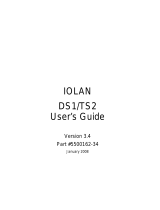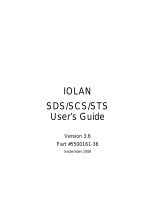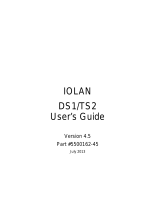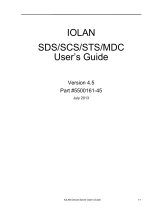Page is loading ...

Operating instruction
Modem 50-2400 baud 500FSD20
EDS500 series - FSK modems
Operating instruction
Modem 50-2400 baud 500FSD20
EDS500 series - FSK modems
Application, characteristics and technical data have to
be taken from the hardware data sheet:
500FSD20 Data sheet 1KGT150986
Operation
The 500FSD20 modem is a voice-frequency telegraphy
unit (VFT unit) which operates according to the
principle of binary frequency shift keying. The modem
can operate in two- and four-wire connection. The
mode of operation is set by a command line interface
(CLI).
Connections
Power connector (X1)
The EDS500 devices are equipped with a wide range
power supply for voltages between 24 and 60 Volts DC
(power consumption see device label). The connector
is a 3-pin Phoenix plug with screw terminals.
Pin allocation power supply (X1)
Pin Signal
1 24-60 V DC
2 Functional earth
1 2 3
3 GND
ADVICE
Due to the internal overvoltage protection,
interrupt any connection to ground of the device
for the time of the measurement before you carry
out isolation measurements. This includes the
earthing of the hat rail as well as all shields of all
transmission lines and supply feedings. RJ-12 plugs
or RJ-45 plugs can also establish earthing via the
shield.
Serial interface to DTE (X2)
The RJ-45 connector X2 forms an RS-232-D interface. If
the modem is connected to an RTU, an adapter cable
has to be used which connects the pin pairs.
Pin allocation serial interface DTE (RJ-45)
RS-232-D
Pin Signal
V.24
Signal
V.28
Direction
8 1
1 DSR M1 107 output
Pin allocation serial interface DTE (RJ-45)
2 DCD M5 109 output
3 DTR S1 108.2 input
4 GND GND -
5 RxD C2 104 output
6 TxD D1 103 input
7 CTS M2 106 output
8 RTS S2 105 input
Interface to transmission line (X3)
In two-wire mode X3-1 and X3-2 form terminal NF1
which is used for transmission and reception.
In four-wire mode X3-1 and X3-2 form the transmitter
terminal NF1 and X3-3 and X3-4 form the receiver pair
NF2.
NF terminals
Transmit Receive
2-wire NF1: X3-1 and X3-2 NF1: X3-1 and X3-2
4-wire NF1: X3-1 and X3-2 NF2: X3-3 and X3-4
Pin allocation transmission line interface (X3)
Pin Signal
1 NF1a
2 NF1b
3 NF2a
4321
4 NF2b
Serial interface for configuration (Con0)
The serial interface of the device is signal compatible
to RS-232. The connector is an RJ-12 female plug. The
factory presets are speed 57600 Baud, no parity, 1
stop bit, no flow control. Via the serial interface the
management console can be accessed .
Pin allocation serial interface RS-232 (RJ-12)
RS-232 RS-232 PC SUB-D9
Pin Signal Direction Pin Signal Direction
1 DCD Output 1 DCD Input
2 CTS Output 8 CTS Input
3 RTS Input 7 RTS Output
4 GND - 5 GND -
5 RxD Output 2 RxD Input
6
1
6 TxD Input 3 TxD Output

Alarm relay (X4)
The devices are equipped with a potential free alarm
output (relay with isolated switchover contact). This
output corresponds to a device alarm and is activated
when the device looses the power supply or the alarm
LED is constantly on. The reason for the signaling of an
alarm can be referenced in the system alarm table.
Pin allocation alarm output (X4)
Pin Signal
1 & 2 Normal state
1 & 3 Alarm state
1 2 3 4
4 Common contact (connected to 1)
WARNING
The relay is designed for switching only safety extra
low voltages.
Signaling
LED Description Function
off Device is without
power supply
Power Voltage
Supply
green Power supply
switched on
off DTE does not
send
RTS Request to
send
green DTE requests
to send via the
modem
off CTS inactiveCTS Clear to
send
green The CTS is
switched on when
the carrier is
being established.
A transmit delay
time of 20-30ms
has to be adjusted
in DTE settings.
off No signal receivedDCD Data carrier
detected
green Modem signal
received
off good signal
quality level
SQL Signal
quality level
alarm
red
•
signal quality
(SQ) below the
SQ threshold
more than 10
times within 4
seconds
•
no carrier is
detected for
more than
a baudrate
dependent
time
off tranmitter/
receiver test
function inactive
EQZ Equalizer
flash
yellow
0 Hz = best result
25 Hz = worst
result
LED Description Function
off No activity on the
Con0 interface
Con0 Con0
activity
green Data is trans-
mitted via Con0
off No alarm
flash Warning or
configuration
error
Alarm Alarm
red Alarm
Configuration using a serial configuration cable
The serial interface provides access to the command
line. Using a serial configuration cable (500CAB06
1KGT038912R0001), the device can be connected to a
serial port of a PC/notebook.
The default configuration for the serial connection is:
57600 Baud 8N1 (8 data bits, no parity, 1 stop bit), no
hardware flow control.
The command line interface
The command line of the 500FSD20 is similar to the
(DOS) command line known from the PC. All device
properties can be set and shown here.
•
Commands are typed into the console, pressing
<{Enter}> will start execution.
•
Commands can be abbreviated as soon as they
are unambiguous, i.e. <sh sy> is equivalent
to <show system>, <se i f w 4> is
equivalent to <set interface fsk0 wire
4>.
•
A command overview can be listed on every level
by typing <?>. Example: <sh al ?> translates
to <show alarm ?> and results in active
enabled being shown as command keywords
to follow, i.e. one possible command is <show
alarm active>.
•
There are two authentication levels on the
command line: Login authentication and Enable
authentication. Login authentication can be
described as a read only mode and is accessible
directly after establishing a serial connection
with the PC. Enable authentication is required
once you need to change system settings or
show the complete system parameter set.
Enable authentication is reached by entering
the <enable> command. Both authentication
levels can be protected by a password, the
respective commands are <set loginpass
{string20}> and <set enablepass
{string20}>.

•
Configuration commands entered on the
command line interface are stored in the running
configuration of the device, which represents the
current state of the system. To preserve this status
after a reboot, the running configuration must
be transferred to the startup configuration using
the command <write>. During system startup
all commands from the startup configuration
are being executed and thus create the running
configuration. When a configuration stick is
attached to the device, executing the <write>
command results in the running configuration
being copied not only to the startup configuration
but also to the stick configuration (unless the stick
is set to “read only”). During system startup with
attached config stick, the stick configuration over-
writes the startup configuration.
•
The current configuration (running configuration)
can be displayed using the command <show
running-config> (only with Enable
authentication). The start configuration may be
shown using <show startup-config>.
When a config stick is attached, its content can be
shown using <show stick-config >.
System settings
System Identification Settings
For an easier identification of the devices several
description parameters can be set:
•
Hostname: <set system hostname
{name}>
•
Contact: <set system contact
{contact}>
•
Location: <set system location
{location}>
•
Description: <set system description
{text}>
Reset button
Pressing the reset button restarts the device and
loads the saved configuration (startup-config or stick-
config). As a protection against accidental triggering,
the reset button is in a concealed place and can be
reached with a pointed tool (e.g. paper clip).
If the reset button is pressed for more than 5 s, the
modem enters firmware update mode.
ADVICE
If the running configuration (= running-config)
does not match the savedconfiguration (= startup-
config) it is lost with the restart.
ADVICE
The established communication connection will be
lost temporarily during restart.
Firmware Update
The firmware is updated by transferring a firmware
image to the device. This is accomplished by first
pressing the reset button for longer than 5 seconds
to put the modem into firmware update mode.
Then with CON0 of the modem connected to a
PC via a serial cable, open a command window
in Windows on that PC. Change the directory
to the path containing the firmware image and
bootloader software. Then type the command
<serial_flash_programmer.exe -d
f2803x -k f2803x_flash_kernel.txt -
a MOPS-binary -p COMx -b 9600 –v>
where MOPS-binary is the filename of the 500FSD20
firmware, e.g. MOPS-1.0.2.bin, and COMx
denotes the number of the serial port of the PC to
which CON0 of the 500FSD20 is connected. After the
firmware is successfully transferred to the modem, the
reset button needs to be pressed for a restart.
ADVICE
During a firmware update the power supply
must not be interrupted or a reboot must not
be triggered as this could leave the device in an
inoperable state.
Safety
DANGER
Interrupt the power supply before mounting or
dismounting the device.
WARNING
An easy to access manual interrupter has to be
installed into the power feed of the modem to be
able to disconnect the modem from the power
supply in the case of an emergency.
WARNING
The EDS500 devices are intended only for use
in restricted access area. For fire protection
the devices have to be mounted into suitable
cubicles which are certified for the function of a fire
protection housing.
WARNING
The DC power supply has to fulfil the following
requirements in order to supply appropriate fire
protection:
•
Limited power source according to IEC 60950-1
or PS2 classified according to IEC 62368-1
•
Short-circuit current < 8A
WARNING
The device shall be powered off while accessing
any of the connectors X1 (power connector)or X4
(alarm relay). Any other connectors (e.g. RS-232or
4-wire/2-wire communication port/X3) are hot-
pluggable while the device is operating.

WARNING
No plug shall be freely accessible in normal
operation due to safety reasons.
Installation
ADVICE
The EDS500 devices are protection class
II device with functional earthing.
Correct functional earthing is
accomplished by snapping the modem
on the properly earthed DIN-rail (making
contact to backside functional earth
contacts) and additionally connecting
terminal X1-2 (SHIELD) to an earthing
terminal on the DIN-rail.
WARNING
Functional earthing must be done
properly in order for the overvoltage
protection of the modem to work
properly.
"Fig. 4: Schematic installation drawing" shows a
schematic drawing of the correct installation of the
modem. X1-2 has to be connected to functional earth.
Terminal X1-1 is connected to the positive terminal and
X1-3 to the negative terminal of a DC power supply.
The communication line can be either connected in
two-wire or four-wire configuration. For two-wire
configuration connect terminal X3-1 and X3-2 to the
pair of wires. For four-wire configuration connect
terminal X3-1 and X3-2 to the pair of wires used for
transmit direction and X3-3 and X3-4 to the pair used
for receive direction.
The internal transformers of the 500FSD20 have
a galvanic isolation of 3 kV. If a higher level of
protection is needed, additional isolation low-
frequency (LF) transformers have to be used.
See "Fig. 5: Communication line connection by LF
transformer (two-wire connection)" and "Fig. 6:
Communication line connection by LF transformer
(four-wire connection)"for the installation scheme.
Finally, the serial interface has to be connected to the
local data termination equipment (DTE) by connecting
X2 of the 500FSD20 to the serial interface of the DTE
by a shielded serial cable, e.g. 500CAB08.

Figure 1: 560FSD20
Figure 2: 500FSD20 Front plate
Figure 3: 500FSD20
Label
X1
X3
X2
1 2 3
1 2 3 4
Connect DIN-rail to
Protection earth
1
.
.
.
8
Figure 4: Schematic installation drawing
NF2a
NF2b
NF1a
NF1b
Z
0
Z
0
A1 A1
E1 E1
A2 A2
E2 E2
S
P
T-T
T-R
NF1
NF2
OVP
OVP
Figure 5: Communication line connection by LF transformer (two-wire connection)

NF2a
NF2b
NF1a
NF1b
Z
0
Z
0
A1 A1
E1 E1
A2 A2
E2 E2
S
P
A1 A1
E1 E1
A2 A2
E2 E2
S
P
T-T
T-R
NF2
NF1
Receive
Transmit
LF signal transformer
OVP
OVP
Figure 6: Communication line connection by LF transformer (four-wire connection)
ABB Power Grids Germany AG
P.O. Box 10 01 64
68128 Mannheim, Germany
Tel. +49 621 381-3000
www.abb.com/remote-terminal-units
We reserve the right to make technical
changes or modify the contents of this
document without prior notice. With
regard to purchase orders, the agreed
particulars shall prevail. ABB Power
Grids Germany AG does not accept any
responsibility whatsoever for potential
errors or possible lack of information in
this document.
We reserve all rights in this document and in
the subject matter and illustrations contained
therein. Any reproduction, disclosure to third
parties or utilization of its contents – in whole
or in parts – is forbidden without prior written
consent of ABB Power Grids Germany AG.
Copyright© 2019 ABB Power Grids Germany AG
All rights reserved
1KGT150987 V001 1
/



